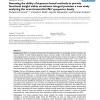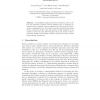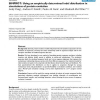62 search results - page 9 / 13 » Taxonomic colouring of phylogenetic trees of protein sequenc... |
BMCBI
2006
13 years 7 months ago
2006
Background: Since the publication of the first draft of the human genome in 2000, bioinformatic data have been accumulating at an overwhelming pace. Currently, more than 3 million...
BMCBI
2007
13 years 7 months ago
2007
Background: Efforts to predict functional sites from globular proteins is increasingly common; however, the most successful of these methods generally require structural insight. ...
RECOMB
2006
Springer
14 years 8 months ago
2006
Springer
Abstract. A probabilistic graphical model is developed in order to detect the dependent evolution between different sites in biological sequences. Given a multiple sequence alignme...
BMCBI
2005
13 years 7 months ago
2005
Background: General protein evolution models help determine the baseline expectations for the evolution of sequences, and they have been extensively useful in sequence analysis an...
BMCBI
2007
13 years 7 months ago
2007
Background: There are a number of different methods for generation of trees and algorithms for phylogenetic analysis in the study of bacterial taxonomy. Genotypic information, suc...



